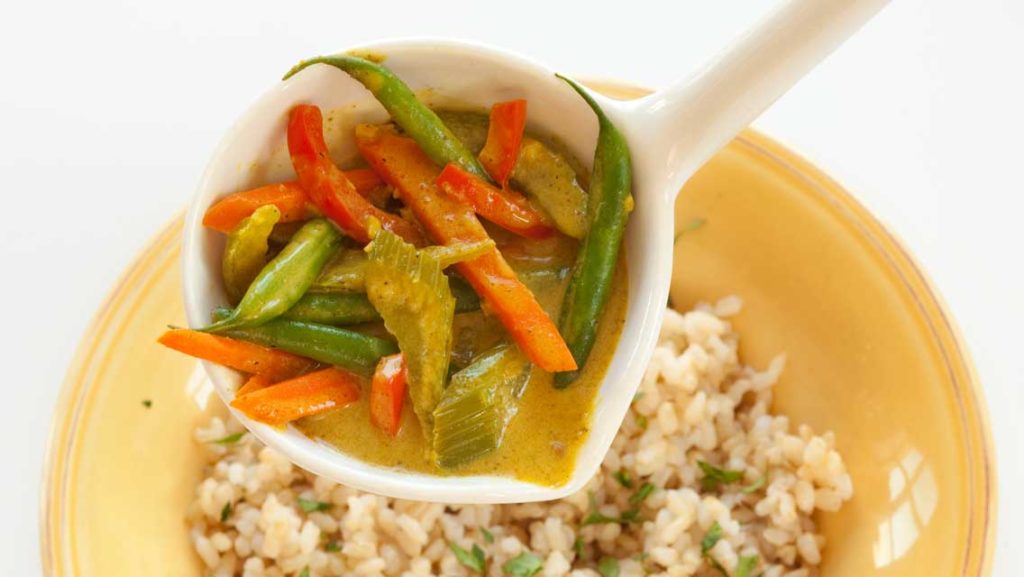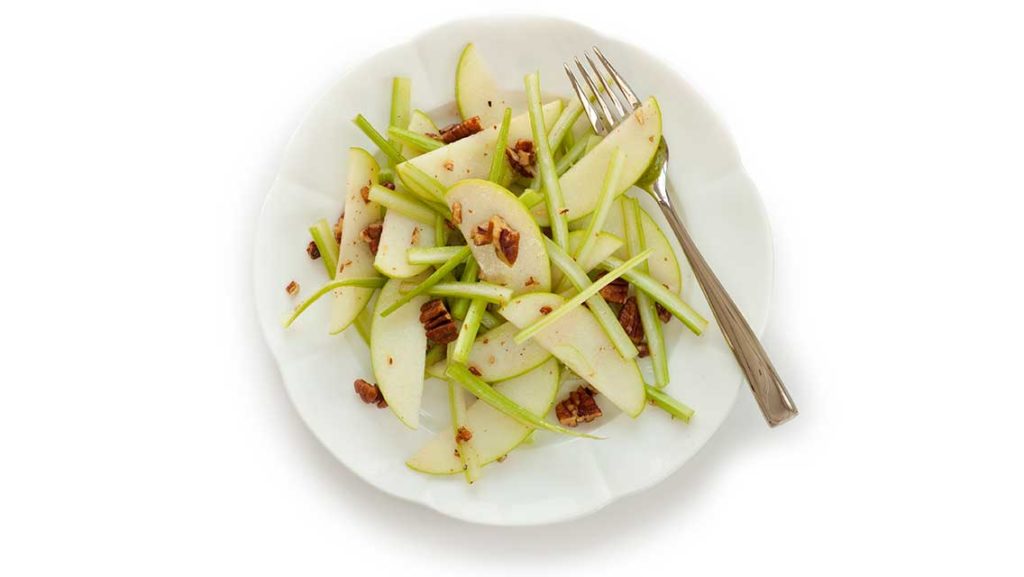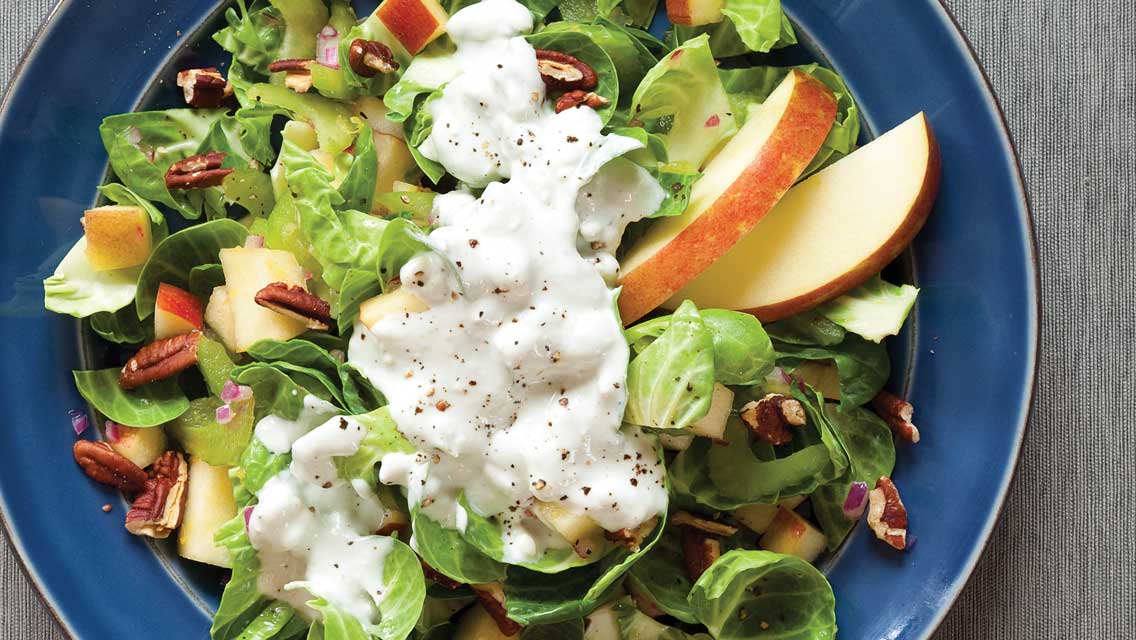Celery’s reputation as a diet food in no way does justice to its culinary strengths and subtleties. Here’s a vegetable about which most of us know little except that it’s “mostly water” and has “practically no calories.” Such characterizations damn celery with excruciatingly faint praise — while its reputation for stringiness burdens it with undeserved liabilities. Happily, it’s what many of us have yet to discover about celery — its extraordinary perfume, its delicate flavor, its nourishing, detoxifying and protective effects on both brain and body — that matter so much more.
Mildly salty, with light pine and citrus notes, this aromatic vegetable is a member (with parsnip, fennel and parsley) of the carrot family. Celery’s outer stalks, also called ribs, surround the tender, mildly flavored innermost ribs, called the celery heart. (Note that what’s known as “celery root,” also called celeriac, makes for great eating, but it comes from a different variety of celery plant.) Most celery is light green, but you can also find white celery (which, like white asparagus, is grown shaded from direct sunlight) and the more intensely flavored red celery. Celery seeds can be used whole or ground as a seasoning.
The vegetable’s bold texture and crunch can bring a satisfying contrast to all kinds of dishes. And its leaves, too often discarded, are supremely edible, adding a dash of good flavor — and celery’s highest concentration of nutrients — to salads, soups or virtually any other dish.
Nutrition Know-How
- A new study published in the Journal of Nutrition shows that luteolin — a bioactive plant compound found in celery, carrots, peppers, olive oil, peppermint, rosemary and chamomile — reduces age-related inflammation in the brain and may help prevent memory loss.
- Celery contains coumarins, compounds that help prevent free radicals from damaging cells. Coumarins also enhance the ability of certain white blood cells to eliminate harmful cells, including cancer cells.
- One serving of raw celery — about two to three stalks, or a little more than 1 cup chopped — provides 44 percent of the daily suggested amount of vitamin K (good for blood and bones) and 14 percent of vitamin C (an immune-system booster).
- Celery is a good source of potassium, calcium and magnesium, all associated with reduced blood pressure.
- The acetylenics in celery have been shown to inhibit tumor growth.
- Celery contains active compounds called phthalides, which contribute to celery’s distinctive aroma and help lower blood pressure, reduce inflammation, improve circulation and aid detoxification.
Shopping and Storage Tips
- Buy only organic celery. Conventionally grown celery continues to top the list as the dirtiest of the Environmental Working Group’s “Dirty Dozen,” the 12 fruits and vegetables most likely to retain pesticide contamination. In the EWG’s samples, 95 percent of conventionally grown celery — nearly all of it assessed after rinsing — tested positive for pesticides, and 85 percent contained multiple pesticides. (While the average number of pesticides found on these celery samples was 3.79, one sample tested positive for 13 different chemicals. In the tests, 67 different pesticides were found on the various celery samples.)
- Choose tightly formed bunches of celery with crisp, light green and glossy ribs. Dark green ribs tend to be more fibrous and stringy.
- Store celery, with the ribs attached to the base, in a plastic bag. It will keep in your refrigerator’s produce crisper for about two weeks.
- Save celery leaves separately. Loosely wrap in a damp paper towel, then store refrigerated in a plastic bag for about a week.
Kitchen Tricks
- Try adding chopped celery to dishes that may need a little boost of fresh flavor or texture. Both celery’s saltiness and crunch bring out the best in otherwise simple backgrounds, like tuna and egg salad sandwiches.
- To crisp up raw celery before serving, soak it in cold water.
- The outer stalks of a head of celery tend to be stronger flavored. Use these in soups, stuffings or sauces when you want more pungent flavors. The delicate inner stalks are great sautéed and added to milder dishes like rice pilaf, risotto, sauces, or soups like cream of celery or broccoli.
- Various cuts (diced, julienned, chiffonade, grated, puréed) bring out celery’s diverse qualities. Celery, thinly sliced, makes an excellent base for green and vegetable salads of all kinds.
- Don’t be afraid to experiment — or to begin using celery as a staple ingredient, like food guru Dorothy Kalins does. She writes: “Celery is my onion; a rough dice with carrots is the way my cooking starts. The aroma of celery softening in oil confirms for me a kind of primal connection.
5 Celery Classics
There are plenty of ways to get this versatile veggie into your diet.
- To make French mirepoix, an essential base for soups, sauces, stuffing and more, combine one part diced celery, one part diced carrot and two parts diced onion, then sauté in olive oil or butter until softened and richly aromatic. (The “holy trinity” in Cajun cooking is equal parts chopped celery, onion and green pepper. Sauté these vegetables in butter or olive oil and use them as a base for jambalaya, gumbo, étouffée and soups.)
- For a refreshing snack, cut celery and jicama into sticks and season with fresh-squeezed lemon juice, chili powder and chopped cilantro. Enjoy as is, or with your favorite dips, like hummus (chickpeas, tahini, garlic, olive oil and lemon) or tzatziki (yogurt, garlic and cucumbers)
- Add celery leaves to soups, broths and salads, or as an attractive, edible garnish for fish and shellfish dishes (they’re a great sub for cilantro). Celery leaves are more nutritionally dense than the stalks, especially in vitamin C, vitamin A and potassium. So, if you’re lucky enough to find leaf-topped celery stalks, use them!
- Upgrade “ants on a log”: Get creative by substituting almond or cashew butter for peanut butter, and, instead of raisins, top celery with chopped dried apricots, cherries or cranberries. Or consider “aphids on a log” — top a base of nut butter, cream cheese, hummus or mashed avocado with toasted pumpkin or sunflower seeds.
- Liven up Brussels sprouts: Sauté three stalks of chopped celery and 1 pound halved Brussels sprouts in olive oil until bright green. Stir in heavy cream or coconut milk to coat vegetables. Simmer for three to four minutes and season with zest and juice of one lemon and 1 tablespoon of chopped chives, grated Parmesan and pepper.
Egg Salad with Celery and Dill
Celery adds texture and freshness to this classic salad recipe. Try it on whole-kernel rye toast, in a sprouted-grain wrap or on a bed of baby greens. Also good with flaxseed crackers.

Makes | four servings
- 8 large eggs
- 1/3 cup finely chopped celery,
- with leaves
- 3 tbs. mayonnaise or plain
- Greek yogurt
- 1 tsp. Dijon mustard
- 1 tbs. chopped fresh dill
- Pinch of salt and pepper to taste
- 4 pieces whole-kernel rye bread
- Pinch of paprika, optional
Directions
- Cover eggs with cold water in a medium saucepan, cover pan and bring to a rolling boil. Turn off heat and let rest for 10 minutes. Rinse eggs under cold water to stop cooking process.
- Peel the eggs, chop and place in mixing bowl. Mix in celery, mayonnaise or yogurt, Dijon mustard, dill, salt and pepper.
- Toast the rye bread and cut into points or triangles, then arrange on a plate with egg salad. Dust with paprika if you like.
Curried Vegetables
This aromatic curry gives vegetables oomph and makes the most of celery’s famous crunch. Serve over steamed basmati brown rice. Top with peanuts and lime if you like. Nice with tofu or chicken.

Makes | four servings
- 1 1/2 tbs. extra-virgin olive oil
- 1 tsp. minced fresh ginger root
- 4 cloves garlic, minced
- 11/2 tbs. curry powder
- 2 carrots, peeled and sliced on the bias
- 4 stalks of celery, sliced on the bias
- 1 red bell pepper, julienned
- 1 cup green beans
- 1 cup coconut milk
- 1 tbs. chopped cilantro
Directions
- Heat a sauté pan over medium-high heat, then add the olive oil, ginger, garlic and curry. Cook for one minute, stirring continually.
- Add in carrots, celery, red peppers and green beans and sauté for five minutes until the carrots and green beans have just softened.
- Turn heat to low, slowly pour in coconut milk and heat through.
- Garnish with cilantro to serve.
Celery, Apple and Pecan Salad with Lemon Hazelnut Dressing
This light, energizing salad — infused with the fresh flavors of celery, tart apples and toasted pecans — makes a great snack or side. For more substance, add a shaving of Asiago or Manchego cheese.

Makes | six servings
- 8 stalks of celery, leaves removed
- 1 cup toasted pecan halves, chopped
- 1 cup thinly sliced, chopped or diced Granny Smith apple
Dressing:
- 1/4 cup unsweetened apple juice
- 2 tbs. lemon juice
- 2 tbs. hazelnut, walnut or extra-virgin
- olive oil
- 1/4 tsp. sea salt
- 1/4 tsp. freshly ground black pepper
- 1 tsp. honey
Directions
- Cut 3-inch-long pieces of celery into thinly julienned strips or whatever shape you prefer.
- In a mixing bowl, combine the salad ingredients.
- In a separate bowl, whisk together the dressing ingredients, then toss with the salad.


This Post Has 0 Comments